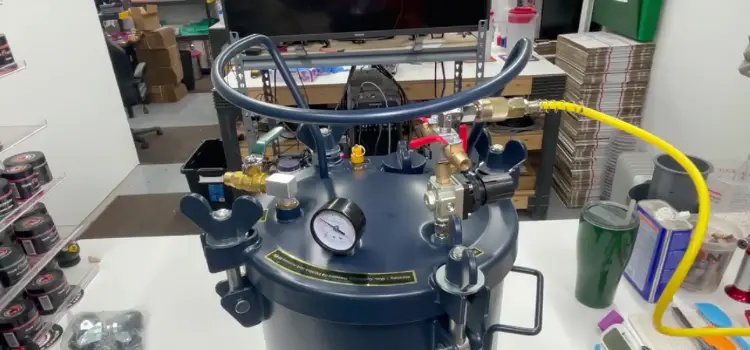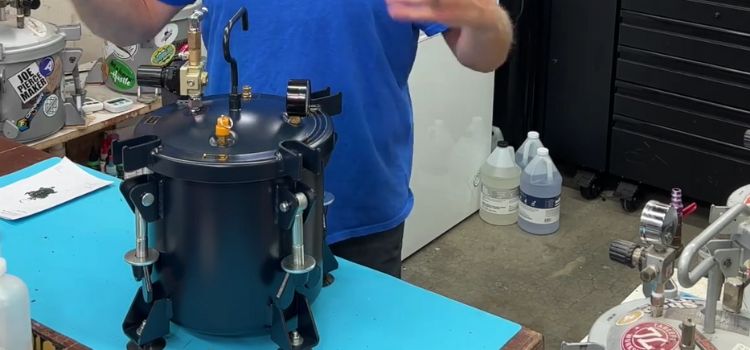As an Amazon Associate, I earn from qualifying purchases

Resin crafting has surged in popularity, becoming a beloved hobby for many creative souls worldwide. This versatile medium allows for the creation of stunning art pieces, exquisite jewelry, and unique home décor items. As the craft gains traction, enthusiasts are constantly on the lookout for innovative tools and techniques to perfect their art. One such unconventional tool that has emerged in discussions is the pressure cooker.
Traditionally a kitchen staple, the pressure cooker is being eyed by some crafters as a potential game-changer in resin casting. But can this household appliance truly be used for resin, and if so, how safely and effectively?
Benefits of Using a Pressure Cooker for Resin
- Eliminates Air Bubbles: Pressure cookers effectively remove pesky air bubbles that often form in resin crafting, enhancing the clarity and smoothness of the finished piece. This leads to a more professional appearance.
- Improves Finish Quality: By applying pressure to compress the resin, pressure cookers help achieve a clearer and smoother finish, elevating the overall aesthetic of resin projects.
- Cost-Effective Alternative: Using a pressure cooker is a budget-friendly option compared to specialized resin pressure pots, which can be expensive. This makes it accessible for beginners or those looking to save money.
- Repurposes Kitchen Appliances: For crafters who already own a pressure cooker, repurposing it for resin work is a practical solution, allowing for efficient crafting without the need for additional investment.
Risks and Considerations
However, before you rush to repurpose your pressure cooker, it’s important to weigh the risks and considerations. Safety is paramount, and using a pressure cooker not intended for resin can pose hazards. Pressure cookers are designed for cooking, not crafting, and the materials used in resin can release fumes or react differently under pressure than food. This can lead to potential risk of damage or malfunction of the cooker.
Additionally, using a pressure cooker for resin could void any warranties or violate manufacturer guidelines, possibly leaving you without support if something goes wrong. It’s crucial to understand the limits of household pressure cookers and consider whether the risk is worth the potential reward.
Step-by-Step Instructions for Safe Use

If you decide to proceed with using a pressure cooker for resin, following these steps can help mitigate risks:
- Prepare the Cooker: Start by thoroughly cleaning the pressure cooker to remove any food residue. Some crafters recommend lining the interior with a non-reactive material to prevent resin from sticking or causing damage.
- Modify if Necessary: Consider minor modifications, like disabling automatic shut-off mechanisms, which might interfere with the resin curing process. However, proceed with caution and at your own risk.
- Pour and Set Up: Carefully mix your resin according to the manufacturer’s instructions. Pour it into your mold and place it inside the pressure cooker, ensuring there’s enough space for the resin to expand slightly without touching the sides.
- Secure and Monitor: Ensure the lid is tightly secured. Turn on the pressure cooker, gradually increasing pressure to a safe level. Monitor the process closely to prevent overheating or excessive pressure buildup.
- Curing Process: Allow the resin to cure under pressure for the recommended time. Once complete, slowly release the pressure and let the cooker return to room temperature before opening.
Alternative Methods for Resin Casting
For those hesitant to use a pressure cooker, traditional resin casting techniques remain reliable. Patience and careful mixing can minimize bubble formation, while using a heat gun or torch can help pop surface bubbles.
Alternatively, pressure pots specifically designed for resin are available. These provide the benefits of pressure casting without the associated risks of using inappropriate equipment.
Vacuum chambers offer another option for removing air bubbles, using suction rather than pressure to achieve a smooth finish. While these can be more affordable than pressure pots, they require careful handling and setup.
Conclusion
In conclusion, while using a pressure cooker for resin is an intriguing concept, it’s not without its challenges and risks. For some, the potential benefits of smoother, bubble-free resin pieces make it worth exploring. However, safety should always be the priority, and all potential risks should be thoroughly considered.
Whether you choose to experiment with a pressure cooker or opt for traditional or alternative methods, the key is to ensure you’re crafting safely and effectively. Resin crafting is all about creativity and innovation, and with the right approach, you can achieve beautiful, professional-quality results while enjoying the process.
FAQ
How to use a pressure cooker for resin?
To use a pressure cooker for resin, first clean it thoroughly. Pour mixed resin into a mold and place it inside. Seal the lid and slowly increase pressure to remove air bubbles. Monitor closely, then let pressure release naturally before opening. This technique can enhance resin clarity.
Can you use a pressure cooker to get bubbles out of resin?
Yes, a pressure cooker can help remove bubbles from resin by compressing them under pressure, resulting in a smoother finish. However, ensure safety measures are followed, as pressure cookers aren’t designed for resin. Consider potential risks and follow step-by-step guidelines for best results.
Can resin withstand pressure?
Resin can withstand moderate pressure, which can help in eliminating air bubbles during the curing process. However, excessive pressure can cause damage or deformation. It’s important to use the right amount of pressure and follow recommended guidelines to ensure the integrity of the resin piece.
As an Amazon Associate, I earn from qualifying purchases